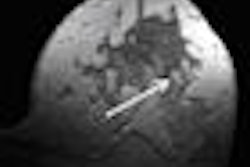Performing a "second-look" ultrasound study can offer value for evaluating suspicious incidental lesions discovered on breast MRI, according to a pair of Italian studies presented at the 2009 European Congress of Radiology (ECR) in Vienna.
In the first talk, researchers from the University of Verona found that follow-up ultrasound offers a number of benefits in characterizing suspicious breast lesions incidentally found on breast MRI.
"[Second-look ultrasound] provides localization and accurate characterization of lesions, provides useful guidance for biopsy or for preoperative localization, and reduces the number of MRI-guided biopsies," said Dr. Anna Russo.
The Verona researchers studied 530 consecutive patients who received a second-look ultrasound for lesions that were suspicious on MRI but not revealed by previous conventional imaging. Ultrasound was performed using a 7-10 MHz linear transducer, with evaluation limited to the region of interest.
The study team then reviewed the results of the previous mammography and ultrasound exams, breast MRI images, second-look ultrasound studies, and either cytological and histological findings or follow-up at six months. Of the 530 patients, 51 (9.7%) received a second-look ultrasound study.
The second-look ultrasound was positive in 37 (72.6%) of 51 cases. In 11 (29.7%) of these 37 cases, ultrasound characterized the lesion as benign, which was confirmed by follow-up, Russo said. The remaining 26 cases received either cytological or histological biopsy; 18 (69%) were malignant.
Of the 14 cases in which second-look ultrasound was negative, nine with a low degree of suspicion for cancer received follow-up at six to 12 months. The other five cases with a high degree of suspicion for cancer received histological biopsy. Ultimately, 10 (72%) of the 14 cases were benign, while four (28%) were malignant.
Concordant results
The Verona study reached similar conclusions as a separate study performed by a team from the University of Rome "La Sapienza," which found second-look ultrasound to be valuable for depicting and diagnosing incidental lesions on preoperative breast MRI.
"Second-look ultrasound allows for ultrasound-guided percutaneous biopsy, which is cheaper and faster than MR-guided biopsy," said presenter Dr. Maria Laura Luciani. "It also facilitates preoperative planning if malignancy is confirmed."
Seeking to evaluate the role of follow-up high-resolution ultrasound for identifying incidental, enhancing lesions found on preoperative breast MRI, the study team enrolled 182 patients with confirmed breast cancer (based on conventional x-ray mammography or ultrasound) in a trial between January 2004 and March 2006.
All patients received breast MRI with 0.1 mmol/kg gadobenate dimeglumine for the purposes of breast cancer staging. Those patients with additional lesions detected on breast MRI then underwent a second-look high-resolution ultrasound exam directed specifically at the site of the incidental finding, Luciani said. The imaging studies were then compared in a blinded fashion by two radiologists in consensus.
Of the 182 patients, breast MRI discovered 55 additional lesions that were not seen on x-ray mammography or the initial ultrasound study in 46 patients (25.3%). Of these 55 lesions, 42 (76.4%) were detected on second-look ultrasound.
In these 42 lesions found on ultrasound, 24 (57.1%) were subsequently confirmed as malignant, compared with seven (53.4%) of the 13 lesions that did not have an ultrasound correlate. Breast MRI provided three false-positive findings and zero false negatives, while second-look ultrasound had eight false positives and two false negatives, she said.
Of the 13 lesions detected on MRI but not found on second-look ultrasound, only one was confirmed as malignant during MR-guided biopsy or reassessment by contrast-enhanced breast MRI after three months.
Treatment planning was altered for four patients with multicentric cancer and seven patients with multifocal cancer based on the combined breast MRI and ultrasound findings, according to the researchers.
"Directed second-look ultrasound is a valuable technique for depiction and diagnosis of incidental enhancing lesions detected on preoperative MRI," Luciani said.
By Erik L. Ridley
AuntMinnie.com staff writer
April 1, 2009
Related Reading
Automated breast US unit not ready to replace handheld, study finds, March 16, 2009
Ultrasound, MRI perform well in dense breasts, March 8, 2009
3D Doppler evaluation helps identify malignant breast lesions, November 6, 2008
Breast ultrasound CAD helps doctors find smaller lesions, October 10, 2008
Breast ultrasound CAD performance varies in ethnic populations, September 5, 2008
Copyright © 2009 AuntMinnie.com




.fFmgij6Hin.png?auto=compress%2Cformat&fit=crop&h=100&q=70&w=100)




.fFmgij6Hin.png?auto=compress%2Cformat&fit=crop&h=167&q=70&w=250)











